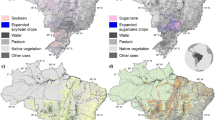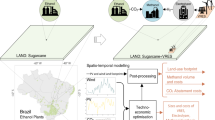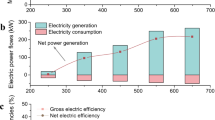Abstract
Reduction of CO2 emissions will require a transition from fossil fuels to alternative energy sources. Expansion of Brazilian sugarcane ethanol1,2 provides one near-term scalable solution to reduce CO2 emissions from the global transport sector. In contrast to corn ethanol, the Brazilian sugarcane ethanol system may offset 86% of CO2 emissions compared to oil use, and emissions resulting from land-use change to sugarcane are paid back in just 2–8 years3,4. But, it has been uncertain how much further expansion is possible given increasing demand for food and animal feed, climate change impacts and protection of natural ecosystems. We show that Brazilian sugarcane ethanol can provide the equivalent of 3.63–12.77 Mb d−1 of crude oil by 2045 under projected climate change while protecting forests under conservation5 and accounting for future land demand for food and animal feed production. The corresponding range of CO2 offsets is 0.55–2.0 Gigatons yr−1. This would displace 3.8–13.7% of crude oil consumption and 1.5–5.6% of net CO2 emission globally relative to data for 20146,7.
This is a preview of subscription content, access via your institution
Access options
Access Nature and 54 other Nature Portfolio journals
Get Nature+, our best-value online-access subscription
$29.99 / 30 days
cancel any time
Subscribe to this journal
Receive 12 print issues and online access
$209.00 per year
only $17.42 per issue
Buy this article
- Purchase on Springer Link
- Instant access to full article PDF
Prices may be subject to local taxes which are calculated during checkout


Similar content being viewed by others
References
De Souza, A. P., Grandis, A., Leite, D. C. C. & Buckeridge, M. S. Sugarcane as a bioenergy source: history, performance, and perspectives for second-generation bioethanol. Bioenerg. Res. 7, 24–35 (2014).
Somerville, C., Youngs, H., Taylor, C., Davis, S. C. & Long, S. P. Feedstocks for lignocellulosic biofuels. Science 329, 790–792 (2010).
Searchinger, T. et al. Use of US croplands for biofuels increases greenhouse gases through emissions from land-use change. Science 319, 1238–1240 (2008).
Mello, F. F. C. et al. Payback time for soil carbon and sugarcane ethanol. Nat. Clim. Change 4, 605–609 (2014).
Sparovek, G., Barretto, A. G. O. P., Matsumoto, M. & Berndes, G. Effects of governance on availability of land for agriculture and conservation in Brazil. Environ. Sci. Technol. 49, 10285–10293 (2015).
BP Statistical Review of World Energy (BP, 2016)https://www.bp.com/content/dam/bp/pdf/energy-economics/statistical-review-2016/bp-statistical-review-of-world-energy-2016-full-report.pdf
Olivier, J. G. J., Janssens-Maenhout, G., Muntean, M. & Peters, J. A. H. W. Trends in Global CO2 Emission: 2015 Report, The Hague (PBL Netherlands Environmental Assessment Agency; Ispra: European Commission, Joint Research Centre, 2015).
GeoSpacial Library - Agroecological Zoning (Brazilian Agricultural Research Corporation, 2014); http://geo.cnpma.embrapa.br/projeto_en.aspx
Magrin, G. O. et al. in Climate Change 2014: Impacts, Adaptation, and Vulnerability (eds Barros, V. R. et al.) 1499–1566 (IPCC, Cambridge Univ. Press, 2014).
Ferreira-Leitão, V. et al. Biomass residues in Brazil: availability and potential uses. Waste Biomass Valorization 1, 65–76 (2010).
Marin, F. R., Thorburn, P. J., Nassif, D. S. P. & Costa, L. G. Sugarcane model intercomparison: structural differences and uncertainties under current and potential future climates. Environ. Model. Softw. 72, 372–386 (2015).
Marin, F. R., Ribeiro, R. V. & Marchiori, P. E. R. How can crop modeling and plant physiology help to understand the plant responses to climate change? A case study with sugarcane. Theor. Exp. Plant Physiol. 26, 49–63 (2014).
Miguez, F. E., Zhu, X., Humphries, S., Bollero, G. A. & Long, S. P. A semimechanistic model predicting the growth and production of the bioenergy crop Miscanthus × giganteus: description, parameterization and validation. Glob. Change Biol. Bioenergy 1, 282–296 (2009).
Cooper, M., Mendes, L. M. S., Silva, W. L. C. & Sparovek, G. A national soil profile database for Brazil available for international scientists. Soil Sci. Soc. Am. J. 69, 649–652 (2005).
Sugarcane Production and Procesing per Harvesting (Brazilian sugarcane industry association (UNICA), 2016)http://www.unicadata.com.br/historico-de-producao-e-moagem.php?idMn=32&tipoHistorico=4
Bodirsky, B. L. et al. Global food demand scenarios for the 21st century. PLoS ONE 10, e0139201 (2015).
Nelson, G. C. et al. Climate change effects on agriculture: economic responses to biophysical shocks. Proc. Natl Acad. Sci. USA 111, 3274–3279 (2014).
Rosenzweig, C. et al. Assessing agricultural risks of climate change in the 21st century in a global gridded crop model intercomparison. Proc. Natl Acad. Sci. USA 111, 3268–3273 (2014).
Warszawski, L. et al. The Inter-Sectoral Impact Model Intercomparison Project (ISI–MIP): project framework. Proc. Natl Acad. Sci. USA 111, 3228–3232 (2014).
Loiola, M. L. & Souza, F. Statistics on irrigation in Brazil according to the 1995–1996 agricultural census. Rev. Bras. Eng. Agr. Amb. 5, 171–180 (2001).
Oliveira, M. E. D., Vaughan, B. E. & Rykiel, E. J. Ethanol as fuel: energy, carbon dioxide balances, and ecological footprint. BioScience 55, 593–602 (2005).
Galdos, M., Cantarella, H., Hastings, A., Hillier, J. & Smith, P. Advances of Basic Science for Second Generation Bioethanol from Sugarcane (eds Buckeridge, M. S. & De Souza, A. P.) 177–195 (Springer, 2017).
Watanabe, M. D. B. et al. Hybrid input-output life cycle assessment of first- and second-generation ethanol production technologies in Brazil. J. Ind. Ecol. 20, 764–774 (2016).
Le Mer, J. & Roger, P. Production, oxidation, emission and consumption of methane by soils: a review. Eur. J. Soil Biol. 37, 25–50 (2001).
Otto, R. et al. Nitrogen use efficiency for sugarcane-biofuel production: what is next? Bioenerg. Res. 9, 1272–1289 (2016).
Crutzen, P. J., Mosier, A. R., Smith, K. A. & Winiwarter, W. Paul J. Crutzen: A Pioneer on Atmospheric Chemistry and Climate Change in the Anthropocene (eds Crutzen, P. J. & Brauch, H. G.) 227–238 (Springer, 2016).
Projections of Agribusinesses. Brazil 2013/14 to 2023/24. Long-Term Projections. Report No. MAPA/ACS, 1–98 (Ministry of Agriculture, Livestock and Food Supply, 2014).
Electric Power Transmission and Distribution Losses (World Bank, 2014); http://data.worldbank.org/indicator/EG.ELC.LOSS.ZS
Losordo, Z. et al. Cost competitive second-generation ethanol production from hemicellulose in a Brazilian sugarcane biorefinery. Biofuels Bioprod. Biorefin. 10, 589–602 (2016).
Tao, L., Schell, D., Tan, E. C. & Elander, R. NREL 2012 Achievement of Ethanol Cost Targets: Biochemical Ethanol Fermentation via Dilute-Acid Pretreatment and Enzymatic Hydrolysis of Corn Stover (National Renewable Energy Laboratory, 2014); http://www.nrel.gov/docs/fy14osti/61563.pdf
Leahy, J. Brazilian ethanol producer sees boost from plant waste. Financial Times (25 July 2017); https://www.ft.com/content/366b86e4-5933-11e7-9bc8-8055f264aa8b
Lee, H. Turning the focus to solutions. Science 350, 1007 (2015).
Larsen, S., Jaiswal, D., Bentsen, N. S., Wang, D. & Long, S. P. Comparing predicted yield and yield stability of willow and miscanthus across Denmark. Glob. Change Biol. Bioenergy 8, 1061–1070 (2016).
Miguez, F. E., Maughan, M., Bollero, G. A. & Long, S. P. Modeling spatial and dynamic variation in growth, yield, and yield stability of the bioenergy crops Miscanthus × giganteus and Panicum virgatum across the conterminous United States. Glob. Change Biol. Bioenergy 4, 509–520 (2012).
Wang, D. et al. A physiological and biophysical model of coppice willow (Salix spp.) production yields for the contiguous USA in current and future climate scenarios. Plant Cell Env. 38, 1850–1865 (2015).
Collatz, G., Ribas-Carbo, M. & Berry, J. Coupled photosynthesis-stomatal conductance model for leaves of C4 plants. Funct. Plant Biol. 19, 519–538 (1992).
Leakey, A. D. B. et al. Photosynthesis, productivity, and yield of maize are not affected by open-air elevation of CO2 concentration in the absence of drought. Plant Physiol. 140, 779–790 (2006).
LeBauer, D. S. et al. BETYdb: a yield, trait, and ecosystem service database applied to second-generation bioenergy feedstock production. Glob. Change Biol. Bioenergy http://dx.doi.org/10.1111/gcbb.12420 (2017).
University of São Paulo. Brazil Soil Database (accessed 27 March 2014); http://www.esalq.usp.br/gerd
Reichert, J. M. et al. Estimation of water retention and availability in soils of Rio Grande do Sul. Rev. Bras. Cienc. Solo. 33, 1547–1560 (2009).
Braga, R. L. C. Jr, Oliveira, I. A., Souza Andrade, F. & Nardy, V. Censo Varietal e de Produtividade em 2012 (CTC, 2012).
Hempel, S., Frieler, K., Warszawski, L., Schewe, J. & Piontek, F. A trend-preserving bias correction - the ISI-MIP approach. Earth Syst. Dynam. 4, 219–236 (2013).
Nychka, D., Furrer, R., Paige, J., Sain, S. & Nychka, M. D. R Package ‘fields’ (2017); http://www.image.ucar.edu/fields
ESRI 2011, ArcGIS Desktop. Release 10 (Environmental Systems Research Institute, 2011).
Macedo, I. C., Leal, M. R. L. V. & Hassuani, S. J. Sugarcane residues for power generation in the sugar/ethanol mills in Brazil. Energy Sustain. Dev. 1, 77–82 (2001).
Schogor, A. L. B. et al. Losses in sugarcane submitted to different harvesting methods. Revista Brasileira de Zootecnia 38, 1443–1450 (2009).
Long, S. P. et al. Bioenergy and Sustainability: Bridging the Gaps (eds Souza, G. M., Victoria, R. L., Joly, C. A. & Verdade, L. M.) (SCOPE/72, 2015).
Brazilian Institute of Geography and Statistics (IBGE) Table 1612 - Planted Area, Area Harvested, Quantity Produced, Average Yield and Production Value of Temporary Crops (2014); https://sidra.ibge.gov.br/Tabela/1612
Brazilian Institute of Geography and Statistics (IBGE) Table 73 - Effective of Herds, by Type of Herd (Series Closed) (2014); https://sidra.ibge.gov.br/Tabela/73
Brazilian Institute of Geography and Statistics (IBGE) Table 264 - Area of Agricultural Establishments by Land Use - Historical Series (1970/2006) (2014); https://sidra.ibge.gov.br/Tabela/264
Brazilian Institute of Geography and Statistics (IBGE) Table 281 - Effective of Animals in Agricultural Establishments by Type of Herd - Historical Series (1970/2006) (2014); https://sidra.ibge.gov.br/Tabela/281
De Souza, A. P. Photosynthetic mechanism and source-sink relationship in sugarcane grown in elevated CO2. PhD thesis, Univ. São Paulo (2011).
Patzek, T. W. & Pimentel, D. Thermodynamics of energy production from biomass. Crit. Rev. Plant Sci. 24, 327–364 (2006).
Pereira, S. C., Maehara, L., Machado, C. M. M. & Farinas, C. S. 2G ethanol from the whole sugarcane lignocellulosic biomass. Biotechnol. Biofuels 8, 1–16 (2015).
Preston, T. R. Nutritive value of sugarcane for ruminants. Trop. Anim. Prod. 2, 125–142 (1977).
Annual Sugar Report (International Sugar Organization, 2009); http://www.isosugar.org
Alexandratos, N. & Bruinsma, J. World Agriculture Towards 2030/2050: The 2012 Revision (Food and Agriculture Organization of the United Nations, 2012).
Vasconcelos, J. N., Lopes, C. E. & Franca, F. P. Continuous ethanol production using yeast immobilized on sugar-cane stalks. Braz. J. Chem. Eng. 21, 357–365 (2004).
Miller, K. Solid–liquid separation technologies in the conversion of bagasse to liquid fuel. MS thesis, Louisiana State Univ. (2010).
Dwivedi, P. et al. Cost of abating greenhouse gas emissions with cellulosic ethanol. Environ. Sci. Technol. 49, 2512–2522 (2015).
Jaiswal, D. et al. Brazilian Sugarcane Ethanol as an expandable green alternative to crude oil use. Dryad Digital Repositoryhttp://dx.doi.org/10.5061/dryad.222j0.
Acknowledgements
D.J. and S.P.L. acknowledge the financial support of the Energy Bioscience Institute and the Center for Advanced Bioenergy and Bioproducts Innovation, both within the University of Illinois. D.J. acknowledges advice from D. Tanjore of Lawrence Berkeley National Lab on calculations related to second-generation ethanol production and J. R. Soares of University of Campinas on issues related to nitrogen in Brazilian sugarcane operation. S.P.L. acknowledges the support of the Newton-Abrahams Visiting Professorship at the University of Oxford, UK.
Author information
Authors and Affiliations
Contributions
D.J. and S.P.L. led the study and analysis. D.J., A.P.D.S. and S.P.L. drafted the manuscript with support from S.L., D.S.L., F.E.M., G.S., G.B. and M.S.B. S.L. and G.S. assisted with soil, land-use data and developing land-use change model. A.P.D.S. and M.S.B. collected data from the Brazilian literature and databases for evaluating model performance and current status of ethanol industry in Brazil. D.S.L. assisted in obtaining climate data to perform simulations. D.J., F.E.M., G.B. and S.L. contributed to the development of the model to project sugarcane production.
Corresponding author
Ethics declarations
Competing interests
The authors declare no competing financial interests.
Supplementary information
Supplementary Information
Supplementary Information (PDF 2208 kb)
Rights and permissions
About this article
Cite this article
Jaiswal, D., De Souza, A., Larsen, S. et al. Brazilian sugarcane ethanol as an expandable green alternative to crude oil use. Nature Clim Change 7, 788–792 (2017). https://doi.org/10.1038/nclimate3410
Received:
Accepted:
Published:
Issue Date:
DOI: https://doi.org/10.1038/nclimate3410
This article is cited by
-
Using crop models, a decline factor, and a “multi-model” approach to estimate sugarcane yield compared to on-farm data
Theoretical and Applied Climatology (2024)
-
Sugarcane water requirement and yield projections in major producing regions of China under future climate scenarios
Theoretical and Applied Climatology (2024)
-
Conservation of native tree species in the agroforest of rice-based agroecosystems will contribute to sustainable agriculture
Biodiversity and Conservation (2023)
-
Dynamic changes in soil fungal communities and functional groups in response to sugarcane/soybean intercropping with reduced nitrogen fertilizer application
Biology and Fertility of Soils (2023)
-
Multi-experiment assessment of soil nitrous oxide emissions in sugarcane
Nutrient Cycling in Agroecosystems (2023)



